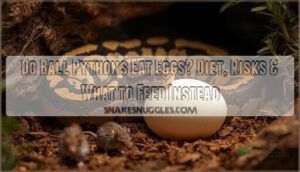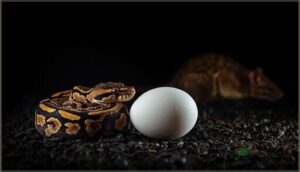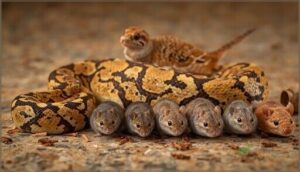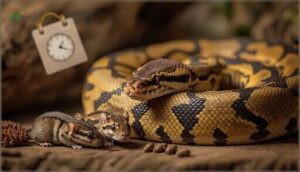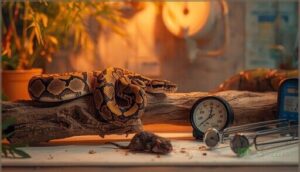This site is supported by our readers. We may earn a commission, at no cost to you, if you purchase through links.
Your neighbor casually mentions feeding chicken eggs to their ball python, and you freeze—something about that doesn’t sound right. Ball pythons are constrictors built to hunt warm-blooded prey, with feeding behaviors and digestive systems optimized for rodents and small mammals, not avian eggs. While some snake species have evolved specialized anatomical features to consume eggs whole, Python regius lacks these adaptations entirely.
Yet the question persists among reptile keepers, often fueled by well-meaning but misinformed advice. Understanding what ball pythons actually need—and why eggs fall dangerously short—protects your snake from nutritional deficiencies, digestive complications, and potentially serious health consequences that many owners don’t recognize until damage is done.
Table Of Contents
Key Takeaways
- Ball pythons lack the specialized anatomical adaptations for egg consumption that true egg-eating snakes possess, making eggs both structurally inappropriate and nutritionally inadequate for their carnivorous digestive systems.
- Whole rodent prey delivers the complete calcium-phosphorus balance, essential amino acids, and organ tissue that ball pythons evolved to process, while eggs create dangerous nutritional deficiencies and metabolic bone disease risks over time.
- Feeding eggs introduces immediate health threats including bacterial contamination from Salmonella, digestive distress from improper nutrient ratios, and potential regurgitation—complications you’ll avoid by sticking with appropriately sized frozen-thawed rodents.
- Your ball python’s hunting instincts center on heat-detecting and constricting warm-blooded mammals, not passive egg collection, which means their feeding behavior and biological needs align exclusively with rodent-based diets rather than avian alternatives.
Do Ball Pythons Eat Eggs?
Do ball pythons eat eggs? The short answer is no—not under normal circumstances.
While these snakes can physically consume eggs in rare situations, their biology, diet, and feeding behavior tell a very different story about what they’re actually built to eat.
Ball Python Diet in The Wild
In the wild, ball pythons are ambush predators with a natural diet focused almost entirely on small mammals—especially rodents like mice and rats. Their hunting strategies rely on heat detection and constriction to subdue prey near burrows or open ground.
Foraging behavior peaks at night, when wild snake behavior aligns with rodent activity. Birds occasionally supplement their feeding habits, but eggs? Rarely part of the equation.
Understanding language patterns can help us better describe the complex behaviors of these animals.
Differences From Egg-Eating Snakes
Ball pythons and true egg-eating snakes—like Dasypeltis—couldn’t be more different. While egg specialists evolved striking jaw structure and skull adaptations for oophagy, your ball python lacks these durophagous traits entirely.
Consider these key differences:
- Egg-eaters possess extreme gape flexibility; ball pythons don’t.
- Gastric function in egg specialists processes shells; ball pythons process mammalian prey.
- Ecological niches differ—egg-eaters target clutches, ball pythons hunt rodents.
- Digestive enzyme profiles vary notably between species.
Snake feeding and husbandry practices should reflect these biological realities.
A solid understanding of how to care for a ball python means matching your setup to their natural needs, not the other way around.
Rare Circumstances of Egg Consumption
Though structurally unprepared for oophagy, your ball python might encounter eggs under rare conditions. Captive breeding anomalies occasionally lead to opportunistic feeding behavior—especially when nutritional stress factors drive sick or juvenile snakes toward accidental egg exposure.
If your python refuses typical prey due to illness or stress, understanding normal ball python feeding patterns and fasting tolerance helps you distinguish between temporary food strikes and genuine nutritional emergencies.
However, egg ingestion risks remain significant. These incidents don’t validate eggs as appropriate reptile diet and nutrition; they’re aberrations in proper snake feeding and husbandry practices, not guidelines.
Nutritional Needs of Ball Pythons
Your ball python’s body is built for one thing: processing whole prey animals, not individual food components. Understanding what nutrients they actually need—and why whole rodents deliver them perfectly—helps you see why eggs fall short.
Let’s break down the protein requirements, compare whole prey to eggs, and look at what happens when the nutritional balance gets skewed.
Poor nutrition during gravid periods can affect egg quality—if substrate moisture isn’t managed properly, you may notice signs that ball python eggs look deflated during incubation.
Protein and Nutrient Requirements
Your ball python’s carnivorous diet demands specific amino acid needs—lysine and methionine, primarily—for tissue repair and growth. Protein sources from whole vertebrate prey deliver balanced mineral balance, especially that critical calcium-phosphorus ratio (1:1 to 2:1) supporting bone health.
While nutrient supplements might seem tempting, they’re generally unnecessary. Reptile nutrition isn’t about shortcuts; it’s about mimicking what snake diet and nutrition evolved to process: complete, appropriate prey items.
That means offering frozen-thawed rodents or other whole prey as outlined in this complete pet snake feeding guide, rather than relying on vitamins or powders.
Whole Prey Vs. Eggs
Think of whole prey as a complete nutritional blueprint—rodents deliver bone, muscle, fat, and organ tissue in balanced ratios that match your ball python’s carnivorous diet. Eggs, by contrast, are nutritionally lopsided: high fat, minimal calcium-phosphorus balance, and no connective tissue.
Whole prey delivers balanced nutrition that eggs cannot—bone, muscle, and organs versus lopsided fat and missing calcium
That’s why feeding strategies grounded in reptile nutrition emphasize species-appropriate prey. Ensuring the right diet is vital for preventing health issues, which can be audited using scientific study methods to verify the nutritional value.
Why whole prey wins for snake diet and nutrition:
- Bone content supplies calcium-phosphorus in ideal ratios, preventing metabolic bone disease
- Connective tissue and fur condition jaw mechanics and support healthy snake digestion
- Complete amino acid profiles from vertebrate muscle tissue meet protein demands for growth and repair
Egg alternatives simply can’t replicate the dietary balance evolution designed your ball python to process.
Risks of Nutritional Imbalance
Metabolic issues and nutrient deficiencies emerge when your ball python’s calcium-to-phosphorus ratio skews. Overreliance on eggs or single prey types disrupts dietary diversification and triggers malnutrition.
Inconsistent feeding schedules compound obesity risks, while inadequate reptile nutrition starves growth pathways of essential amino acids.
Nutritional balance demands whole-prey animal nutrition and health strategies that honor your snake’s evolutionary blueprint, not substitutes lacking real nutritional value.
Health Risks of Feeding Eggs
Even if your ball python could eat an egg, that doesn’t mean it should. Eggs introduce several health risks that can compromise your snake’s well-being, from immediate digestive distress to long-term nutritional deficiencies.
Here’s what you need to watch for if you’re considering eggs—or if your python has already consumed one.
Digestive Issues and Malnutrition
Feeding eggs regularly can throw your ball python’s digestive system into chaos. Eggs lack the calcium-phosphorus balance their metabolism demands, triggering malabsorption risks and nutrient deficiency over extended periods.
This dietary insufficiency impacts gut health and can progress to metabolic disorders like bone demineralization—a preventable crisis in reptile nutrition when you stick to proper snake feeding practices with whole rodent prey.
Bacterial Contamination Concerns
Raw eggs carry Salmonella and other pathogens that threaten your ball python’s health—egg safety isn’t just about bacterial risks, it’s about contamination control through rigorous hygiene practices. Cracked shells and improper food handling create breeding grounds for microbes that compromise reptile health and wellness.
You’ll protect your snake by prioritizing whole rodent prey over eggs, maintaining strict sanitation protocols that support ideal animal nutrition and snake feeding practices in ball python care.
Recognizing Adverse Reactions
Your ball python might refuse food, regurgitate within 24–72 hours, or show loose stools—these adverse reaction signs demand immediate attention and digestive issue management. Watch for lethargy or respiratory wheeze, rare but serious indicators requiring veterinary emergency response.
If egg feeding triggers these symptoms, revert to proven rodent prey and seek reptile nutrition counseling to restore proper snake nutrition and reptile health and wellness through expert-guided animal nutrition protocols.
Why Eggs Are Not Recommended
While eggs might seem like a convenient alternative, they’re fundamentally incompatible with your ball python’s biology. These snakes haven’t evolved the specialized adaptations needed to make eggs a viable food source, and the nutritional gaps create real problems over time.
Let’s look at three key reasons why eggs simply don’t work for ball pythons.
Biological Adaptations and Mouth Structure
Unlike African egg-eating snakes with specialized skull structure adaptations, your ball python (Python regius) evolved different jaw mechanics optimized for rodent consumption. Their mouth anatomy reveals why eggs aren’t ideal:
- Recurved, backward-facing teeth grip struggling prey rather than manipulating smooth shells
- Flexible jaw ligaments enable wide gapes for mammal ingestion, not delicate egg handling
- Limited salivary enzymes mean their digestive system relies on gastric acid to process whole prey
- Kinetic skull joints enable swallowing fur-covered rodents head-first, not fragile oval objects
This feeding behavior design makes rodents the natural choice.
Hunting and Feeding Behavior
Your ball python’s hunting strategy centers on ambush tactics—patiently waiting, then striking warm-blooded prey with lightning speed. This predator employs constriction methods to subdue struggling rodents, not passive egg collection. Snake feeding habits reflect gape limitation: selecting prey that fits their body width, detected through heat-sensing pits. Eggs don’t trigger these instinctive feeding strategies.
| Prey Selection Factor | Rodent-Based Diet | Egg-Based Diet |
|---|---|---|
| Heat signature detection | Strong infrared cues | Minimal thermal output |
| Movement triggers | Active struggling prey | Static, no motion |
| Constriction requirement | Essential for subduing | Unnecessary for shells |
| Feeding frequency pattern | Seasonal, prey-dependent | Not naturally encountered |
Lack of Essential Nutrients in Eggs
Beyond behavior, egg protein lacks methionine and critical amino acids your ball python needs for muscle development. Nutrient deficiencies emerge quickly—eggs contain insufficient calcium-phosphorus balance, minimal iodine for thyroid function, and wrong fatty acid profiles compared to whole rodents.
Mineral imbalance risks metabolic bone disease over time. Even dietary supplements can’t replicate the complete nutritional value found in appropriately sized prey animals.
Safe and Appropriate Food Options
Your ball python’s health depends on feeding the right prey—not eggs, but whole animals that match their natural hunting instincts. Rodents and birds provide complete nutrition, including bones, organs, and fur or feathers that support digestion and overall wellness.
Let’s break down exactly what you should be offering, how to prepare it safely, and how often your snake needs to eat.
Recommended Prey Types (Rodents, Birds)
Your ball python’s diet should center on appropriately sized rodents—mice for juveniles, rats for adults—matching the snake’s midsection width. Rodents deliver complete nutrient balance with protein, fat, calcium, and phosphorus in whole prey form.
Birds like quail can serve as occasional alternatives, though they’re less common due to handling challenges. Stick with consistent prey types to support stable digestion and avoid nutritional gaps that eggs simply can’t fill.
Frozen-Thawed Vs. Live Prey
Frozen-thawed rodents offer safer prey handling, allowing you to avoid bite injuries to your ball python while maintaining consistent snake nutrition. Live prey can trigger natural hunting instincts but increases stress and injury risk during feeding.
Most keepers find frozen-thawed options support better digestive health with proper thawing techniques. *If you choose live feed, never leave prey unsupervised with your snake.
*
Prey Size and Feeding Frequency
Generally, you’ll feed prey roughly equal to the widest part of your ball python’s body. Adults thrive on weekly to biweekly feeding schedules, while juveniles need meals every 5–7 days to support growth monitoring.
Consistent prey size guidelines protect digestive health and nutrient balance—oversized items risk regurgitation, and irregular feed intervals disrupt your snake’s diet stability.
Expert Recommendations for Owners
You’ve learned what ball pythons need and what they don’t—now let’s talk about putting that knowledge into practice. The best way to keep your snake healthy is to stick with proven feeding strategies, know when to ask for help, and stay consistent with their care routine.
Here’s what experienced keepers and reptile vets recommend for long-term success.
Occasional Treats and Monitoring Health
While eggs might seem like an easy treat, they shouldn’t replace your ball python’s core diet of appropriately sized rodents.
If you experiment with an egg, limit treat frequency to rare occasions—perhaps once every few months—and track health metrics like feeding response, body condition score, and digestive balance.
Monitor nutrient intake closely, watching for any shifts in stool consistency or appetite that signal your snake isn’t thriving on non-standard foods.
Consulting Reptile Veterinarians
When dietary questions arise—or if you notice weight loss, lethargy, or digestive trouble—seek specialist consult from a qualified reptile veterinarian. General vets often lack the exotic pet care training needed for ball python health concerns, risking misdiagnosis or improper handling.
- Diagnostic tests like fecal exams and bloodwork catch hidden parasites or metabolic issues
- Emergency services address regurgitation, infections, or respiratory distress fast
- Veterinary care customized to reptile health ensures proper snake feeding guidance and long-term wellness
Maintaining a Balanced Feeding Routine
Your ball python thrives on consistency—set feeding schedules aligned with age and size, using appropriately sized prey selection to maintain nutrient balance. Track growth monitoring through regular weigh-ins, adjusting meal frequency as your snake matures.
A disciplined reptile diet and nutrition routine prevents health complications, ensures proper snake feeding practices, and keeps your ball python’s diet steady. When in doubt, consult a herpetologist to fine-tune your feed plan.
Frequently Asked Questions (FAQs)
Can snakes eat raw eggs?
Some snake species do consume raw eggs in the wild, though rarely. However, raw egg risks include bacterial contamination and nutritional gaps.
Avidin in egg whites can block biotin absorption, affecting reptile diet quality.
Will a python eat a chicken egg?
While a python might consume a chicken egg if offered, it’s not typical behavior.
Eggs lack essential nutrients your snake needs and pose choking risks, making them unsuitable for regular feeding routines.
Can I feed my snake eggs instead of mice?
No, you shouldn’t replace mice with eggs in your snake’s diet. Eggs lack the essential calcium-to-phosphorus ratio and complete nutrient profile that whole prey provides, risking serious nutritional deficiencies and digestive issues.
Can snakes eat cooked eggs?
Cooked eggs aren’t recommended for any snake species, including ball pythons. While some captive snakes may tolerate small amounts, safety concerns and nutritional inadequacy make established whole prey alternatives far preferable for reptile diets.
Can I feed eggs to my snake?
You can, but you shouldn’t make it routine. Eggs lack the complete Egg Nutrition your Ball Python needs from whole prey.
Feeding Alternatives like rodents better support Snake Digestion, Reptile Health, and balanced Diet requirements.
Can ball pythons have eggs?
Yes, ball pythons can technically consume eggs if offered, but this isn’t recommended as part of their regular diet.
Eggs lack essential nutrients your snake needs and may cause digestive issues or bacterial contamination risks.
What not to feed a ball python?
Never feed your ball python raw eggs, dairy, processed foods, insects alone, or seasoned prey. These toxic foods lack essential nutrients, introduce harmful bacteria, and disrupt your snake’s carnivorous diet requirements.
Can python eggs be eaten?
Ball pythons aren’t adapted for oophagy—eggs lack the complete nutrient profile these snakes need.
Whole prey like rodents delivers essential calcium, organ tissue, and balanced nutrition that eggs simply can’t provide for ideal reptile health.
Can ball pythons eat eggs?
While technically possible, feeding eggs to your ball python isn’t recommended. These snakes lack the biological adaptations for egg consumption, and eggs don’t provide the complete nutrition found in whole rodent prey.
What do ball pythons eat?
In the wild, your ball python’s feeding habits center on warm-blooded prey—primarily rodents like rats and mice, with occasional birds.
This dietary foundation shapes their nutrition balance and defines proper prey selection for captive snakes.
Conclusion
An ounce of prevention is worth a pound of cure—especially when your ball python’s health hangs in the balance. While curiosity about whether ball pythons eat eggs is understandable, the evidence speaks clearly: rodents and appropriately sized whole prey deliver the complete nutrition these constrictors require.
Eggs offer incomplete nourishment, digestive risks, and zero evolutionary advantage for Python regius. Stick with proven feeding protocols, consult reptile veterinarians when questions arise, and your snake thrives.
- https://www.linkedin.com/posts/bohdanlukianets_tasks-study-research-activity-7373377539521667072-UTEi
- https://www.britannica.com/science/hypapophysis
- https://x.com/godofprompt/status/1990526288063324577
- https://www.onelook.com/?loc=olthes1&w=subpoint
- https://www.sciencedirect.com/science/article/pii/S0749208123000268

